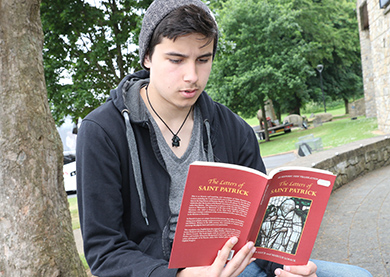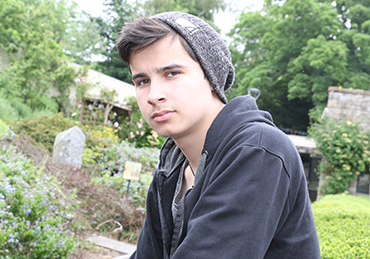My name is Jorge Velasquez. And this is my story. Well, some of it.
As the title suggests, my name is Jorge. From that name alone, I can already tell that some readers have concluded that I am not from here. Well, surprising as it may seem, I am.

My mother is from Kilclief, (very exotic, I know). I was born in Downpatrick and have had a relatively normal life so far. Except for one thing. I haven’t mentioned my father. Now, this is where things get interesting. My father is from a little-known Central American country, called El Salvador which is Spanish-speaking.
This explains where my name originated. The country is quite poor, and when I go over there most years, it gives me a whole new perspective on the world and how people live. The difference between a middle class family and a family scraping an existence on someone else’s plantation is, for wont of a better word, jarring. But, more on that later.
As for me, I go to De La Salle High School in Downpatrick, and the reason, I am on the Down News webpage, is because I am doing my school work experience here. I am currently doing my AS Level, and I study English Language/Literature, Spanish , even though I already speak fluent Spanish (some would call this cheating, but I call it being pragmatic) and I am also doing a Science BTEC. As for where I want to go after A Levels, university would be the ideal option, to do an English Under Grad and then possibly branch out into broadcast journalism.
Back to the meat and potatoes of this article. My name (pronounced HOR-hey, “Hor” rhyming with “war”) is the Spanish equivalent of George, although I would recommend differentiating the two as we (my father, who is also called Jorge, and myself) do not exactly appreciate being called George. As for what I do on holiday, my family and I all go to El Salvador, which is located just south of Guatemala and west of Honduras, with a coastline on the Pacific Ocean. It is not Mexico. It is not part of Mexico and never has been. Let me explain. Not everything below the US is ‘Mexico’, as many people assume, there are a multitude of different countries and cultures south of the US. But before I go and get myself worked up over it, I will add a bit more about El Salvador.
Named after Jesus Christ, (no, really, it means “The Saviour” which is a shortened version of the original name the Spanish gave the country when they first colonized it, which went something along the lines of, “The Colony of Jesus Christ, our Lord and Saviour”) and also known as “ El Pulgarcito de Central America”, or the Tom thumb of Central America is split into thirteen different departments, which are somewhere in between a province and a county over here, which are then split into 236 municipalities, similar to townlands.

Whenever we travel to El Salvador, every summer if we can, we go to my family’s homestead in the westernmost department of the country, Ahuachapan, right on the border with Guatemala.
El Salvador, climate-wise, is much warmer than here in Northern Ireland, and its landscape consists of both rainforests (although many of these are being cleared away for the expansion of urban areas), and and cultivated land.
Four of the eight species of sea turtle, two of which are critically endangered, make their home on the Salvadoran coast, and there are an estimated 500 species of birds, 800 species of marine fish and 1000 different species of butterfly that all inhabit the Salvadoran coastlines and forests. Many insects reside here as well, and we will talk of one particular species next.
Mosquitoes rank among my least favorite creatures in the world, alongside wasps… and people who chew with their mouths open. Mosquitoes spread a disease called ‘Dengue Fever’ among other illnesses throughout the country. Malaria, thankfully, is not one of these, but the last time we went, I came down with a disease that causes fever and joint pain and has been spreading rapidly throughout the populace. It is similar to Dengue Fever but the name is too long to spell and will leave you scratching your head as to how it is pronounced, so i will save you the trouble by simply saying that those few days were not my idea of fun.
I have enjoyed my week in job experience at Down News which is based at the Down Business Centre. Down News was the first interactive internet newspaper to set up in Northern Ireland. Through the week we have been out and about on a number of jobs and it has been very interesting to see how photography and journalism come together to create thought-provoking articles.
I now have an insight into how an online newspaper may operate. Also, I got an insight into journalism, and I understand the media is in a state of flux at the moment. Judging by the information I have read in the NUJ journals, it does not look very well paid although it appears to be an interesting profession.
There has been a significant change in the world of journalism when it comes to hard copy newspapers. And his is not just in Northern Ireland, too. This trend can be seen in the US, the EU and the rest of the world.
To put it simply, the advertisement revenue is not what it used to be, companies now being more likely to post ads on ONLINE newspapers rather than hard copy with lower profits. This is affecting the newspaper journalism industry drastically, and you can see all over, even some of the biggest newspapers in the country are being surpassed by smaller, online newspapers.
The answer to why this is the case is easy to see, when you think about it.
People simply do not have the time to sit around and read a newspaper anymore. People’s lives move too quickly, and it is easier to read a newspaper on a smartphone for free rather than buying the whole newspaper, and you will still be able to read the story that you want, minus the cost, and minus the hassle of having the entire newspaper, when all you want to see are the league fixtures or specific items.
That was my story. Some of it. Hopefully you found reading about it as interesting as I have found working with Down News to be.

























